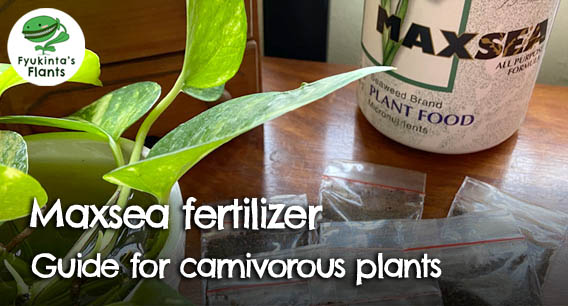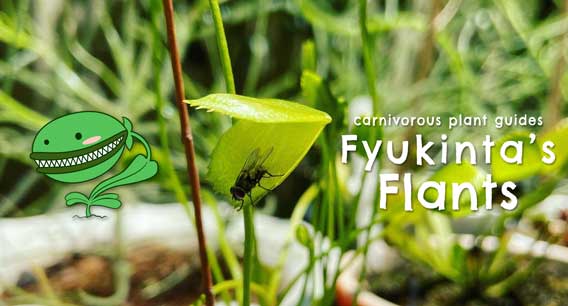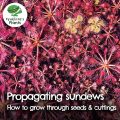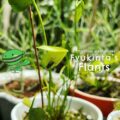ㅤㅤㅤ
Sundews (scientific name drosera) are beautiful carnivorous plants that use their sticky dew to trap and digest their prey. With more than a hundred varieties with varying degrees of difficulty available, it’s always best to look up a particular sundew online first to see if you can give it the care it needs.
This guide will talk about how to care for several basic and affordable sundews you can buy in the Philippines, listed below. I take care of sundews that are easier to grow and can be kept alongside Venus flytraps, pitcher plants (or nepenthes), Byblis, and any other carnivorous plant without any specific difference in care.
 This grow guide covers all the details you need to care for sundews:
This grow guide covers all the details you need to care for sundews:
• Kinds of sundews
• Basic care
ㅤㅤ• Lighting requirements
ㅤㅤ• Watering sundews
ㅤㅤ• Growing medium
• Pot selection and repotting
• How to feed sundews
• Preventing diseases
This guide also has some affiliate links that might give me a small commission if you purchase the items they link to.
This has no additional cost to you whatsoever, as these are all items that I’ve bought and used myself. If you choose to buy any of these items through my links, thank you so much!
Kinds of sundews
Sundews can look very different from each other, with some growing small and button-like while some grow huge. They have a wide variety of leaf shapes and sizes, and some from the petiolaris complex group even look like fireworks (like D. Paradoxa).
Although several sundews can be kept in the same conditions as any carnivorous plant, there are still many others that have specific needs because of their varying habitats. Tropical sundews are more common in the Philippines and are also more affordable to start your carnivorous plant hobby with.
Common sundew species for beginners

Various kinds of sundews
(they’re green because they only got 6 hours of sunlight)
Basic sundews that this care guide can be used for include:
ㅤㅤㅤ

- Adelae
- Binata
- Burmanii
- Burmanii Humpty Doo
- Capillaris
- Eloisiana
- Filiformis
- Indica
- Intermedia
- Paradoxa
- Petiolaris complex
- Spatulata
- Tokaiensis (looks a lot like Spatulata)
- Tracyi (a much larger, green Filiformis)
ㅤㅤㅤ
Click on each link to see them in my collection!
Sundews that need more advanced care
There are many other sundews that are much more advanced in care compared to the species I mentioned above. Some require increased humidity and cool weather. There are also pygmy sundews that are only propagated through gemmae, have dormancy periods, and require very strong light. Some sundews like D. Glanduligera and D. Regia need to digest more prey to survive and will live for just a short time if they can’t catch prey after germinating from seed.
Unfortunately, I can’t list these advanced sundews because I grow and focus on the more basic ones I listed above. If your sundew isn’t included in my list, ask your seller for the sundew’s growing conditions and their best practices to make it thrive.
Basic care for your sundews
Like most carnivorous plants, sundews can thrive with three simple things: strong direct light, low ppm water, and low or no-nutrient media. I’ll break down each of these below.
Lighting Requirements
Sundews need strong direct light, at around 6 hours a day minimum. My plants get light 14 hours a day from grow lights. If you grow your plants outside, ensure they have at least 6 hours of direct sunlight. You can tell if a sundew lacks light through its leaves: a healthy D. Burmannii sundew, for example, will have flat leaves and a red border.
A good rule of thumb is that if your sundew gets enough light, its leaves will be shorter, and its colors will be vibrant. There are only a few exceptions to this, such as sundews that are “anthocyanin-free.” Anthocyanins are responsible for the pigments in plants.
D. Binata with short stems and vibrant red leaves
ㅤㅤㅤㅤ
If you’re growing them indoors, you will need strong grow lights. If you use the Delponting grow lights that I also use, make sure your plants are 6 inches or less away from your plants. They need to be close for the lights to be effective.
Watering sundews
Do NOT use tap water when watering sundews unless your tap water is below 30 ppm. Sundews need low ppm water, and you can measure the ppm of any water using a TDS meter. Examples of water that is usually low in ppm include distilled water (though this can be expensive in the long run), aircon drip water, reverse osmosis (RO) water, and rainwater.
D. Burmannii growing underwater after heavy rains in Sydney
Another thing that I’m often asked is if sundews can get overwatered. The answer is no: you can drown the sundews in my list, and they will be ok. Don’t do it often, but ensure they always have water, especially in the increasing Philippine tropical heat.
Growing Medium
Most local carnivorous plant hobbyists will use sphagnum moss, peat moss, or cocopeat as growing media. These will also usually be mixed with perlite and rinsed or flushed to ensure they are free of salts and minerals. Minerals will burn carnivorous plant roots if not removed from the media.
Sundews aren’t typically picky with media, but I prefer using sphagnum moss for the following reasons:
- Sphagnum moss retains more water for longer
- Sphagnum moss is less messy when watered
- Peat moss and coco peat are much cheaper but can build up minerals faster

Sundews growing in coco peat and sphagnum
Keep this in mind when choosing your media. Your budget and preference will determine your best choice. For example, I more recently prefer to spend a little more money because I don’t have as much time to spare washing media.
Pot selection and repotting
If your sundew already has a pot, there’s no need to repot unless you want to save space in your grow area by making community pots (compots). Most small sundews are ok with small pots. I’ve even had success growing them in take-out tubs with no drainage holes, like in this mini bog below.
How to feed sundews
Do you need to feed sundews?
Yes, sundews need to eat to achieve their best growth, but that doesn’t mean they need to eat often. If you keep your sundews outside, they can catch bugs by themselves. They’re like living flypaper and can easily trap small bugs.
D. Burmannii sundew enjoying a meal
ㅤㅤㅤㅤ
Like I mentioned earlier, some sundews need to eat even as seedlings to survive, but this doesn’t apply to the sundews listed in this guide and the sundews I sell. However, feeding sundew seedlings with either Maxsea or fish food will greatly speed up their growth.
Frequency of feeding
For fun and their general care, I usually feed my sundews with bugs I might catch. Dead bugs are ok, too, since a sundew will wrap their tendrils around the bug. I only do this once a week for one plant. You can’t overfeed your sundew, especially if a large amount of bugs naturally get caught by it. Just make sure to remove food that’s starting to look moldy.
Feeding with Maxsea
If you’re growing sundews indoors or don’t think it’s getting enough bugs to eat, you can also use Maxsea fertilizer. You can spray sundews once a week instead of just twice a week (the usual for Maxsea), but only spray healthy, established plants.
Since some sundews are very small, you can use a pipette to put a drop of diluted Maxsea on a leaf. This has the little added benefit of keeping Maxsea from getting on the media, where it can cause algae to grow. It’s also kind of fun to do. However, do note that too much Maxsea too often can result in leaf burn. The sundew’s leaf will visibly wilt if you use a pipette, but the whole sundew might burn if you apply a spray.
Feeding Maxsea with a pipette!
ㅤㅤㅤㅤ
If you want to learn more about Maxsea, I have a full guide on how to use Maxsea fertilizer. It’s very useful for giving your carnivorous plants nutrients and helping them grow bigger and (slightly) faster.
Feeding with fish food
There are growers that use fish food to feed their sundews. It’s also an easy way to feed sundews that can’t catch bugs. You can use dried bloodworms, fish flakes, or fish pellets for this. Crush them up and mix them with a bit of water to make a paste. Using a dropper or pipette for smaller sundews, drop a little bit of this paste onto sundew leaves the same way you would Maxsea in the video above.
Feeding fish food with a pipette!
ㅤㅤㅤㅤ
Unlike with Maxsea, you’ll have to check to see if the fish food gets moldy. You can remove them with tweezers if that’s the case.
Preventing diseases
One of the worst things that can happen to a sundew, apart from getting too dry, is getting pests. These can include mealybugs, which are white fuzzy things that can grow on sundew roots. If your sundew is declining or looks like it’s dying, check first if the media has a high ppm level by measuring the ppm level of the water that comes out of the pot. I have a video below that shows what I mean.
Checking the ppm of media of a flytrap pot with a TDS meter
ㅤㅤㅤㅤ
If the ppm is high, flush out minerals by top-watering and discarding the water until the water’s level is below 30 ppm. If the water has low ppm but your sundew doesn’t look well (assuming it has enough light too), you can give it Starkle G. Starkle G is a systemic pesticide that gives added protection against pests for a month or so.
The pesticide eventually moves throughout the plant, and the granules remain instead of dissolving (this is how it “lasts”). I don’t use this regularly—I only use it if I notice stunted growth in my plants and they already have low ppm media.
Are you ready to grow sundews?
If you have any questions, feel free to ask in a comment!
Because propagation is an important and fun part of keeping sundews, I dedicated a complete guide to it! Check it out to learn how to propagate certain sundew varieties through seeds and cuttings.
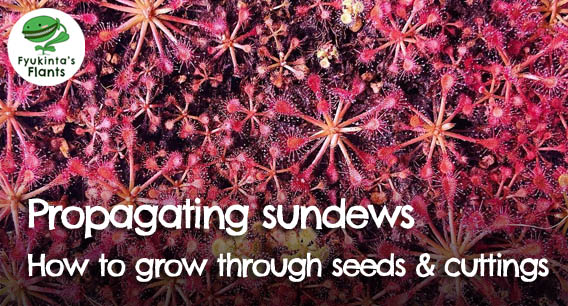
You can also message me on Facebook or Instagram. I post plant content every day about learnings, experiments, and just the regular progress of the plants in my collection.
Check out my other carnivorous plant guides
If you haven’t seen them yet, I have guides on how to prepare for your first carnivorous plant and how to grow other carnivorous plants like Venus flytraps and Byblis in the Philippines. You can check here for all my guides.
Carnivorous plant shop
You can also check what carnivorous plants and gardening items I have for sale in the links below!
I sell Venus flytraps, sundews, pitcher plants, and more carnivorous plants in my online shop, all grown in my own little garden in Marikina. I also have pots, Maxsea fertilizer, and even some non-carnivorous plants available. For grow lights, shelves, and even water trays I use, you can check my Shopee affiliate link collection.
I ship nationwide, and customers can enjoy free shipping and a loyalty card.







